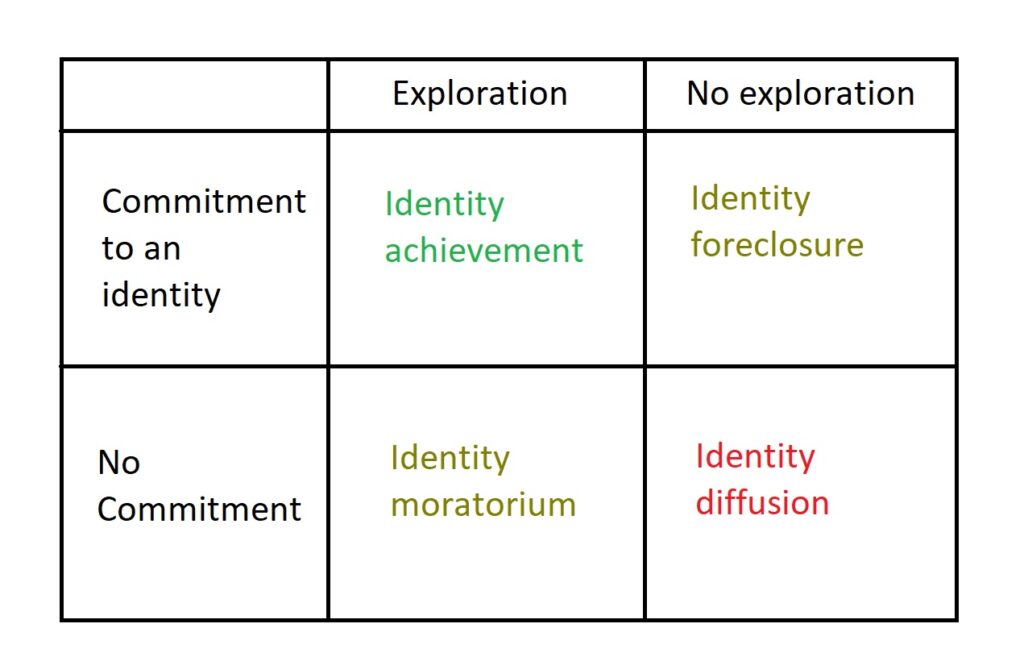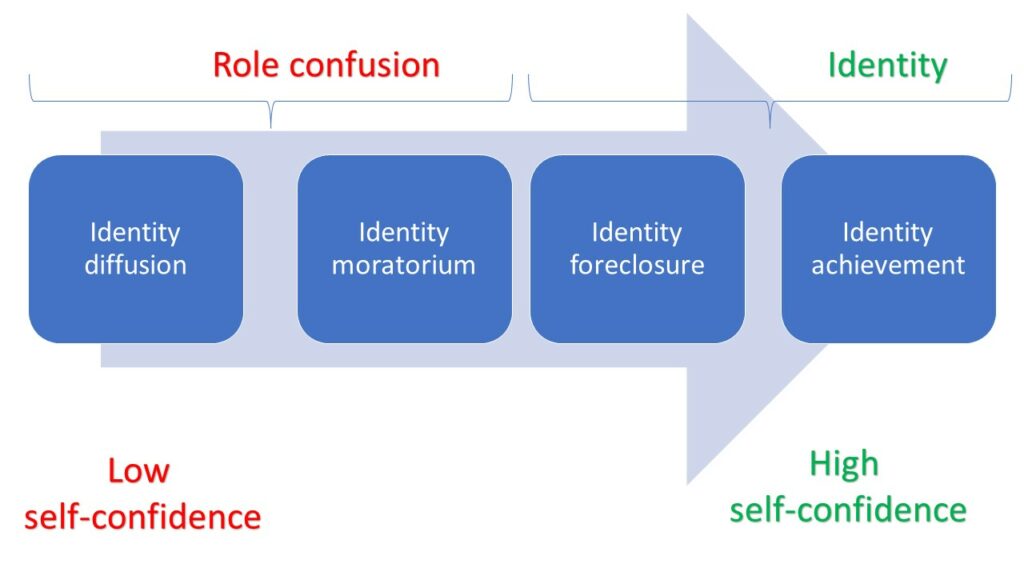Easy Photo of Idenity Vs Role Confusion
The famous psychologist Erik Erikson came up with the stages of psychosocial development. The gist of his theory is that as we progress through life, from the day we're born to the day we die, we go through some developmental stages.
There's a challenge to overcome in each of these stages, a conflict to resolve. When we successfully resolve a developmental challenge, we gain self-confidence and move on to another challenge.
According to Erikson, the most crucial of these stages is the Identity vs. Role confusion stage that people experience in the age range of 12 to 19. During this stage, adolescents are trying to leave behind their childhoods and dip their feet into the waters of adulthood. They're trying to find their place in society.
The goal of Identity vs. Role confusion
The goal of this developmental stage is identity formation. Teenagers will try different identities to see what works for them. Parents and society provide them with the templates to conduct these identity trials. These templates tell them who to be and how to behave.
But teenagers want to experiment with different identities, in addition to the templates. Thus, a conflict ensues. Teens rebel, causing worry to parents, family members, and teachers.
When adolescents find an identity they're comfortable with, this role confusion and trying different identities and personalities ends. This identity formation helps adolescents find their place in society.
Identity formation is an important developmental milestone. It leads to developing a basic virtue that Erikson called 'Fidelity'. Those who develop stable identities experience stability in different life areas. They're committed to their careers and relationships.
In contrast, if role confusion persists, the person feels lost in life and without a purpose. They may jump from one job to another and one relationship to another in a persistent need to find an identity.
Successful identity formation helps one get clear about one's:
- Beliefs
- Values
- Goals
- Interests
Identity states
To further clarify the concept of identity vs. role confusion, researcher James Marcia's contribution to Erkison's work is helpful. He came up with four identity states based on the presence or absence of commitment to an identity and exploration of identity options.
If you're experiencing role confusion, check what identity state you're living in to know what steps to take next to reach identity achievement.

1. Identity diffusion
It's the childhood stage when we're yet to develop a distinct identity. People who experience identity diffusion haven't committed to any identity, nor have they explored the different identity options or templates.
Adults who experience identity diffusion are psychologically children. They seem lost in life with no purpose whatsoever. This is the least mature role confusion state to be in.
Example:
Dave is 16 and is unlike other teenagers. He doesn't engage in any rebellious acts typical of teenagers. He comes home from school, does his homework, and plays video games as he did when he was 12. He doesn't understand the behavior of his peers and why they're acting so weird.
This may be a symptom of delayed puberty, but it's also possible that the adolescent wants to hold on to their childhood to stay away from all the teenage drama.
It's rare to find adults living with identity diffusion. The following identity state is more common- perhaps the most common.
2. Identity foreclosure
It's when adolescents accept an identity that their parents or society impose on them. They don't explore the different identity options out there and blindly become what they're told to become.
It could result from parent-child enmeshment where the child strongly identifies with the parent. Or it could be the result of excessive admiration.
Whatever the reason, the adolescent living with 'identity foreclosure' doesn't go through the confusing process of trying out different identities. They just adopt what's easy and available without much thought.
Example:
Dina, 28, is a research scholar. She never knew what she wanted to do in her life. Her parents told her to take the science stream when she passed high school. Her uncle chimed in, saying there was a lot of scope for a promising career in science.
Today, even though she works at a reputable research institute, she feels unfulfilled. She feels like she's living a borrowed life and playing out a borrowed identity. But she doesn't know what else to do. She hasn't explored other identity options.
3. Identity moratorium
People living in the 'identity moratorium' state of role confusion are exploring the different identity options, but they haven't settled on one yet. This is the state many teenagers find themselves in, and it typically continues into young adulthood.
While they may not be committed to an identity yet, they're getting closer.

4. Identity achievement
When people get clear on who they are, they've achieved identity formation. Not many teenagers develop a stable identity in their teenage years.
With the elongation of education time and the availability of countless career paths in modern times, most develop a stable identity in young adulthood after a long period of identity moratorium.
Once identity achievement happens, the person can then go on and commit to that identity for life and to the career choice and relationships that emanate from that identity.
Example:
John didn't know what to do in life. He wasn't ready to accept his parents' suggestion of becoming an accountant. He just couldn't picture himself being an accountant. He kept trying different things to see what would click.
After trying many things, he decided he wanted to be a musician. He wanted to be a pianist. He wanted himself and the world to see him as a pianist. He decided to become a pianist and got enrolled with a piano teacher.
Years later, he played in concerts and found a partner who was a music enthusiast too.

Hi, I'm Hanan Parvez (MBA, MA Psychology), founder and author of PsychMechanics. I've published one book and authored 400+ articles on this blog (started in 2014) that have garnered over 4.5 million views. PsychMechanics has been featured in Forbes, Business Insider, Reader's Digest, and Entrepreneur. Feel free to contact me if you have a query.
Source: https://www.psychmechanics.com/identity-vs-role-confusion-examples/
0 Response to "Easy Photo of Idenity Vs Role Confusion"
Post a Comment